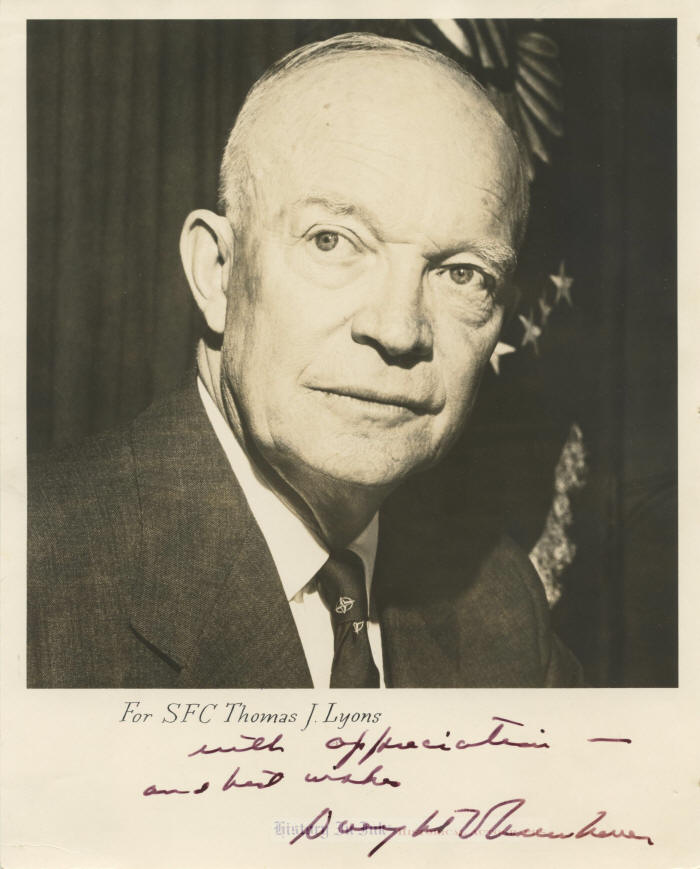2410101
Dwight D. Eisenhower
Scroll down to see the image of the item below the description
Photo signed as President
to the Ward Master at Walter Reed General Hospital
following Eisenhower’s urgent abdominal surgery
Dwight David Eisenhower, 1890–1969. General of the Army; Supreme Commander, Allied Expeditionary Force, World War II; 34th President of the United States, 1953–1961. 8” x 10” black-and-white portrait photograph inscribed and signed, Dwight D. Eisenhower.
This formal presidential portrait of Eisenhower was taken by George Tames, the New York Times’ renowned White House photographer. It is a bust photo of Eisenhower with the presidential flag displayed behind him. Eisenhower has inscribed and signed the photo for Walter Reed General Hospital Sergeant First Class Thomas J. Lyons, the Ward Master on Ward 8, where Eisenhower was hospitalized for more than three weeks after urgent abdominal surgery at Walter Reed in June 1956. Click here to see the letter, which we are offering separately, that Eisenhower wrote to Lyons to thank him for his work.
Nine months after suffering a heart attack, Eisenhower developed an acute intestinal obstruction that resulted in the surgery. Shortly after midnight on June 8, 1956, the President had severe pain in his lower abdomen. His personal physician saw him at the White House and gave him two tap water enemas, but the pain gradually increased, and his abdomen became moderately distended. He vomited 1½ quarts of bile-stained fluid, and his blood pressure dropped.
The Chief of Medicine at Walter Reed, who was summoned as a consultant, found the 65-year-old President “shock-like.” He was “listless, apathetic, perspiring freely, with his skin somewhat cool and clammy and with his normal ruddy color absent.” Once it was safe to move him, doctors took him by ambulance to Walter Reed, where he was seen by four surgical consultants. After testing, they determined that Eisenhower had a small bowel obstruction secondary to regional enteritis. At 1 a.m. on June 9, with Eisenhower’s abdomen showing more marked distention, and with the obstruction “apparently increasing in spite of the correct application of nonsurgical measures,” the doctors unanimously agreed that the President needed surgery.
The question was whether to perform the surgery immediately or wait to see whether the obstruction would pass. After some debate, the doctors unanimously decided to perform the surgery while Eisenhower was still in good enough condition rather than wait until his condition deteriorated to the point that they would be forced to do it.
The surgery began at 2:57 a.m. and took almost two hours. It “was carried out without incident of any kind,” and Eisenhower’s condition “at no time gave rise to any anxiety.”
A full account of Eisenhower’s illness, surgery, and recovery, from which this information and these quotations come, appears in Lt. Gen. Leonard D. Heaton, et al., President Eisenhower’s Operation for Regional Enteritis: A Footnote to History, 159 Annals of Surgery 661 (1964).
Eisenhower spent 22 days at Walter Reed until he was discharged on June 30, 1956. He continued to recuperate at his farm in Gettysburg, Pennsylvania.
Eisenhower’s hospitalization and the urgency of his surgery were important events during the summer of 1956, since Eisenhower was running for reelection as President. Given his popularity, the Democrats did not make his his health as big an issue as they could have, particularly since this surgery followed his heart attack nine months before that left him hospitalized for some seven weeks. They campaigned on the issue indirectly, however, by pointing to Vice President Richard Nixon and arguing that it would be dangerous to elect a candidate who might not survive his four-year term. Democratic nominee Adlai Stevenson expressly warned that Americans had “the solemn obligation to consider with utmost care who will be their president if the elected president is prevented by a higher will from serving his full term.” The 56-year-old Stevenson toured all parts of the country to showcase his good health while Eisenhower largely stayed off the campaign trail. But the travel wore Stevenson down, and by election day Eisenhower, who made only seven major campaign speeches, appeared to be the healthier of the two. Eisenhower easily won reelection, beating Stevenson by a bigger margin in 1956 than he had in 1952. Eisenhower received 57.4% of the popular vote and won 457–73 in the electoral vote in 1956, which bested his 55.2% of the popular vote and his 442–89 win in the electoral vote in 1952.
This is a nice photograph of Eisenhower. It bears a calligraphic inscription to Sergeant First Class Lyons, but Eisenhower has added by hand “with appreciation — and best wishes” and has signed it with a huge 4¼” signature in black fountain pen.
Information on the back of the photo shows that Tames took the photo in April 1956. The photo bears a New York Times copyright notice and a note that it was reproduced by the Army Photographic Agency at The Pentagon. There is light rippling at the top and bottom edges, and there are tape stains at the top and bottom on the back that do not bleed through to the front. The photo is in fine condition.
This photo has an excellent association to Eisenhower’s serious illness and hospitalization in 1956. It is a nice piece for any Eisenhower or presidential collection.
Unframed.
This item has been sold.







